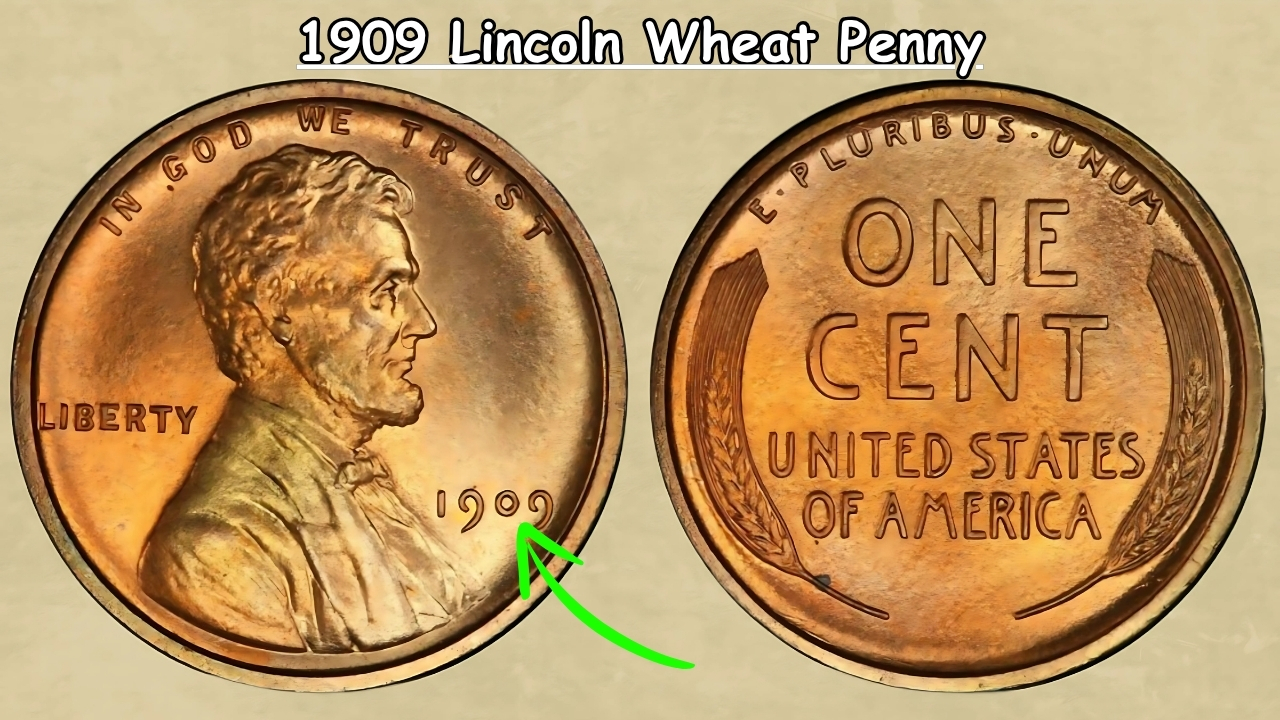1909 Lincoln Wheat Penny : The numismatic world buzzes with excitement over the astronomical valuations of certain 1909 Lincoln Wheat pennies, with combined market values reaching staggering heights.
These humble copper coins, originally worth just one cent, have transformed into some of the most coveted treasures in American coin collecting history.
The 1909 Lincoln Wheat penny marked a revolutionary moment in U.S. currency, being the first circulating coin to feature an actual person’s portrait.
Understanding why these particular pennies command such extraordinary prices requires exploring their unique history, rarity, and significance to collectors worldwide.
Historical Significance of 1909
The year 1909 marked the centennial of Abraham Lincoln’s birth, prompting the U.S. Mint to honor the beloved president with unprecedented recognition.
Victor David Brenner designed the coin, creating an iconic image that would grace American pennies for over a century continuously.
This represented a dramatic departure from previous designs featuring symbolic figures like Lady Liberty rather than actual historical figures.
The wheat ears on the reverse gave the coin its nickname, symbolizing America’s agricultural prosperity and heartland values.
Initial public reaction mixed admiration for Lincoln with controversy over Brenner’s prominent initials “VDB” on the coin’s reverse design.
The Philadelphia and San Francisco mints produced these coins, with production numbers varying dramatically between facilities and creating rarity disparities.
Political pressure forced the removal of Brenner’s initials mid-production, creating distinct varieties that collectors now prize differently.
The coin’s launch coincided with America’s Progressive Era, reflecting changing attitudes about democracy, leadership, and national identity.
The Legendary 1909-S VDB
The 1909-S VDB variety stands as the holy grail of Lincoln penny collecting, with only 484,000 pieces minted in San Francisco.
This mintage represents the lowest production run of any regular-issue Lincoln cent, creating extreme scarcity in today’s collector market.
The “S” mintmark combined with Brenner’s “VDB” initials creates a perfect storm of rarity that drives astronomical values.
Mint State examples of the 1909-S VDB can fetch $250,000 to $2 million depending on grade and eye appeal.
The finest known specimens, graded MS-67 Red by professional grading services, have sold for record-breaking prices at major auctions.
Even heavily worn examples command thousands of dollars, making this penny valuable in almost any condition found.
Counterfeits plague the market due to extreme values, requiring careful authentication by experienced numismatists or grading services.
The mystique surrounding this coin extends beyond rarity, representing the pinnacle achievement for Lincoln cent collectors nationwide.
Other Valuable 1909 Varieties
The 1909 VDB without mintmark from Philadelphia, though more common with 27.9 million minted, still commands premium prices.
High-grade Philadelphia VDB cents can reach $50,000 in pristine condition, particularly with original red copper coloration preserved.
The 1909-S without VDB, minted after the initial controversy, represents another key date with only 1.8 million produced.
Plain 1909 Philadelphia cents without VDB seem common but exceptional specimens still achieve impressive prices in top grades.
Proof versions of 1909 VDB cents, specially made for collectors, number only 420 pieces and command six-figure prices.
Matte proof variants exist in even smaller numbers, representing the ultimate rarity for advanced collectors with unlimited budgets.
Error varieties including double dies, repunched mintmarks, and off-center strikes multiply values exponentially for already rare dates.
The complete 1909 penny set including all varieties represents a significant investment exceeding most people’s retirement savings.
Grading and Authentication
Professional grading services like PCGS and NGC provide crucial authentication and grading that dramatically impacts 1909 penny values.
The Sheldon grading scale from 1-70 determines a coin’s condition, with each point potentially representing thousands in value differences.
Original red coloration (RD) commands highest premiums, followed by red-brown (RB), with brown (BN) examples selling for less.
Surface preservation matters immensely, as contact marks, scratches, or cleaning can reduce values by 90% or more instantly.
Population reports tracking graded examples help establish rarity, with condition census coins achieving record prices when offered publicly.
Certification holders protect valuable coins while displaying grade information, becoming essential for serious collectors and investors alike.
Die varieties identified by specialists can transform common dates into valuable collectibles worth multiples of typical examples.
Expert authentication prevents costly mistakes, as sophisticated counterfeits fool even experienced collectors without proper examination tools.
Market Dynamics and Values
The combined value of all high-grade 1909 Lincoln pennies in existence could theoretically approach $450 million given current market conditions.
Individual collections containing multiple mint state 1909 varieties have sold for millions at major auction houses recently.
Chinese and Asian collectors entering the American coin market have driven prices higher through increased competition for rarities.
Investment funds now include rare coins in alternative asset portfolios, treating them like fine art or vintage wines.
Online marketplaces expanded the collector base globally, creating unprecedented demand for authenticated key date Lincoln cents.
Economic uncertainty often drives collectors toward tangible assets, with rare coins providing both enjoyment and investment potential.
Registry set competitions among collectors push prices higher as participants seek finest known examples for bragging rights.
1909 Lincoln Wheat Penny Preservation and Storage
Proper storage in inert holders prevents environmental damage that could devastate values of these irreplaceable numismatic treasures.
Temperature and humidity control prove essential, as copper coins remain susceptible to spotting and discoloration over time.
Insurance specifically covering coin collections becomes necessary when values reach levels comparable to real estate or luxury automobiles.
Bank safety deposit boxes provide security, though home safes allow easier access for enjoying these miniature masterpieces.
The 1909 Lincoln Wheat penny phenomenon demonstrates how historical significance combined with rarity creates extraordinary collectible values over time.










